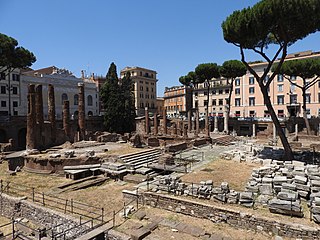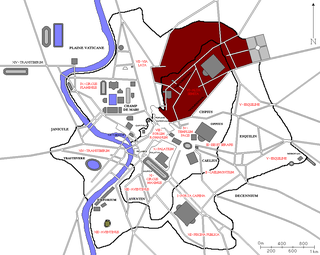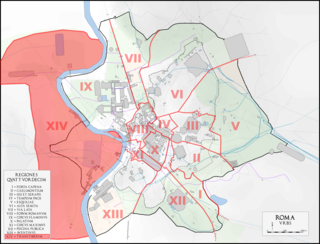
The Regio IX Circus Flaminius is the ninth regio of imperial Rome, under Augustus's administrative reform. Regio IX took its name from the racecourse located in the southern end of the Campus Martius, close to Tiber Island.

The Regio IX Circus Flaminius is the ninth regio of imperial Rome, under Augustus's administrative reform. Regio IX took its name from the racecourse located in the southern end of the Campus Martius, close to Tiber Island.

Regio IX was defined by the presence of the Circus Flaminius, situated on the Campus Martius, whose field stood well into the Middle Ages. In extent, the region was bordered by the Servian Wall and the Ponte Sant'Angelo to the south, the Tiber River to the east, the Aurelian Walls to the north to the point where the Piazza del Popolo sits, and the Via Lata to the west, meaning is occupied the majority of the Campus Martius. The area was devastated by the Great Fire of Rome in the year 64 and another fire in the year 80 almost completely destroyed this region, but was rebuilt by subsequent emperors. [1] A measurement taken at the end of the 4th century recorded that the perimeter of the region was 32,500 Roman feet (approximately 9.62 km), making it the second largest of the Augustan regions. [2]
Attached to the Circus Flaminius were the four stables that belonged to each of the factions in the chariot races: the Red, White, Green, and Blue teams. Additional entertainment was provided at the Amphitheater of Statilius Taurus, and the region also hosted three theatres: the Theatre of Balbus (Theatrum Balbi), which had 11,510 seats; the Theatre of Marcellus (Theatrum Marcelli) which had 17,580 seats; and the Theatre of Pompey (Theatrum Pompeii) which held 22,888 seats. [3] Attached to Pompey's theatre was an enclosed public garden, the Portico of Pompey, while Balbus's theatre was attached to the Crypta Balbi. Other porticos in the region were the Portico of Philippus (Porticus Philippi), which enclosed the Temple of Hercules Musarum; the Portico of Octavia (Porticus Octaviae), which enclosed the Temples of Juno Regina and Jupiter Stator; and the doubled portico of the Porticus Minucia Frumentaria adjacent to the Largo di Torre Argentina. It was from the Minucia that Roman citizens received the grain dole. [4]
Additionally, this region also contained the Portico of Europa, the Portico of the Argonauts (Porticus Argonautarum), and the Porticus Meleagri), the last two being adjacent to the Saepta Julia , where citizens gathered to cast their votes. Finally, near the banks of the Tiber also stood the Porticus Maximae, constructed in the names of the emperors Gratian, Valentinian II and Theodosius I, very near a triumphal arch also built by them which stood in front of the Ponte Sant'Angelo. Near here was also located the Ciconiae Nixae , a name that continues to perplex scholars. [5]

In terms of other types of monuments and buildings, this region possessed the ancient Altar of Mars (located beside the modern Doria Pamphilj Gallery) to the south, while to the north sat the Mausoleum of Augustus. Between these two points stood the Stadium of Domitian (situated on the site of the present day Piazza Navona), the Trigarium (an equestrian training ground located south of the bend of the Tiber River) and the Odeon, built for musical competitions, which was counted amongst the most admired of the works built by the emperor Constantius II. [6] Near the Trigarium was the Tarentum , an open air space where religious rites were carried out.

In this region still stands the Hadrianic reconstruction of the Pantheon of Marcus Vipsanius Agrippa, but the adjacent Baths of Agrippa have long since vanished, as have the Baths of Nero that were later enlarged by Severus Alexander. To the west of the Pantheon stood the Temple of Minerva Chalcidica and the Temple of Isis and Serapis. Several other buildings were constructed in this part of the Regio IX during the period of the Nerva–Antonine dynasty. These included the Temple of Matidia, the Temple of Marcia, the Temple of Hadrian, the Temple of Marcus Aurelius, and two columns, that of Antoninus Pius and Marcus Aurelius. Near where the Column of Antoninus Pius stood was also kept the Solarium Augusti , a giant sundial, as well as the Ara Pacis , the Altar of Peace.
As the lands beyond the Servian Wall were traditionally not held to be part of the city of Rome, the Campus Martius also possessed several tombs, which were not permitted to be placed within the traditional limits of the city. Chief amongst these was the Mausoleum of Augustus, built to house the remains of the emperor and his family. This mausoleum also included the remains of Marcus Vipsanius Agrippa, who had already built a tomb for himself where the Piazza del Popolo now sits. [7] At the turn of the 5th century, the Regio contained 35 aediculae (temples and shrines), 140 domūs (patrician houses), 25 horrea (warehouses), 63 balneae (bath houses), and 120 loci (fountains). [8]
At the turn of the 5th century, the Regio was divided into 35 vici (districts) and 2,777 insulae (blocks). It had two curators and was served by 48 Roman magistrates. [9]

The Campus Martius was a publicly owned area of ancient Rome about 2 square kilometres in extent. In the Middle Ages, it was the most populous area of Rome. The IV rione of Rome, Campo Marzio, which covers a smaller section of the original area, bears the same name.


The Theatre (UK) or Theater (US) of Pompey, also known by other names, was a structure in Ancient Rome built during the latter part of the Roman Republican era by Pompey the Great. Completed in 55 BC, it was the first permanent theatre to be built in Rome. Its ruins are located at Largo di Torre Argentina.

Largo di Torre Argentina is a large open space in Rome, Italy, with four Roman Republican temples and the remains of Pompey's Theatre. It is in the ancient Campus Martius.

Sant'Angelo is the 11th rione of Rome, Italy, located in Municipio I. Often written as rione XI - Sant'Angelo, it has a coat of arms with an angel on a red background, holding a palm branch in its left hand. In another version, the angel holds a sword in its right hand and a scale in its left.

The Saepta Julia was a building in the Campus Martius of Rome, where citizens gathered to cast votes. The building was conceived by Julius Caesar and dedicated by Marcus Vipsanius Agrippa in 26 BCE. The building replaced an older structure, called the Ovile, built as a place for the comitia tributa to gather to cast votes. The Saepta Julia can be seen on the Forma Urbis Romae, a map of the city of Rome as it existed in the early 3rd century CE. Part of the original wall of the Saepta Julia can still be seen right next to the Pantheon.

The Porticus Octavia, also known as the Portico of Octavius, was a portico in ancient Rome built by Gnaeus Octavius in 168 BC to commemorate his capture of Perseus of Macedonia during the Third Macedonian War. It stood between the Theatre of Pompey and the Circus Flaminius beside the Porticus Metelli. Pliny describes it as a double portico with bronze Corinthian capitals, for which it was also called the Corinthian Portico. It may have been the earliest use of this architectural order in Rome and is possibly to be identified with remains on the Via S. Nicola ai Cesarini, represented in the Severan Marble Plan. Velleius Paterculus called it "by far the loveliest" of the porticoes of his time.
During the Middle Ages, Rome was divided into a number of administrative regions, usually numbering between twelve and fourteen, which changed over time.
The Porticus Argonautarum, also known as the Portico of Agrippa was a portico in ancient Rome.

The Regio III Isis et Serapis was the third regio of imperial Rome, under Augustus's administrative reform. Regio III took its name from the double sanctuary of Isis and Serapis, in the area of the Via Praenestina, containing the valley that was to be the future site of the Colosseum, and parts of the Oppian and Esquiline hills.

The Regio IV Templum Pacis is the fourth regio of imperial Rome, under Augustus's administrative reform. Regio IV took its name from the Temple of Peace built in the region by the emperor Vespasian. It includes the valley between the Esquiline and the Viminal hills, the popular area of the Suburra, and the Velian Hill.

The Regio V Esquiliae is the fifth regio of imperial Rome, under Augustus's administrative reform. Regio V took its name from the Esquiline Hill. It contains parts of the Oppian Hill and Cispian Hill and of the Esquiline, plus the plain just outside the Servian Wall.

The Regio VI Alta Semita is the sixth regio of imperial Rome, under Augustus's administrative reform. Regio VI took its name from the street passing over the Quirinal Hill. It was a large regio that also encompassed the Viminal Hill, the lower slopes of the Pincian, and the valleys in-between.

The Regio VII Via Lata is the seventh regio of imperial Rome, under Augustus's administrative reform. Regio VII took its name from the wide urban street the Via Lata. It was the urban section of the Via Flaminia, which ran between the Servian walls and the Aurelian Walls, and corresponds to the modern Via del Corso. The regio contained part of the Campus Martius on the east of the street plus the Collis Hortulorum, the Pincian Hill.

The Regio VIII Forum Romanum Magnum is the eighth regio of imperial Rome, under Augustus's administrative reform. Regio VIII took its name from the Roman Forum, the political centre of Ancient Rome.

The Regio XI Circus Maximus is the eleventh regio of imperial Rome, under Augustus's administrative reform. Regio XI took its name from the Circus Maximus, located in the valley between the Palatine and the Aventine hills.

The Regio XIII Aventinus is the thirteenth regio of imperial Rome, under Augustus's administrative reform. Regio XIII took its name from the hill which dominated the region, the Aventine.

The Regio XIV Transtiberim is the fourteenth regio of imperial Rome, under Augustus's administrative reform. Meaning "across the Tiber", the Regio took its name from its position on the west bank of the Tiber River.
The Arch of Germanicus was an arch of Rome situated at the northern end of the Circus Flaminius.